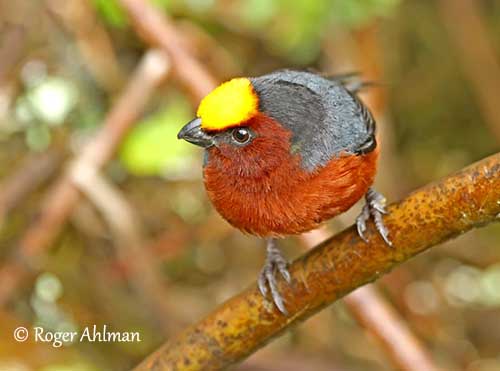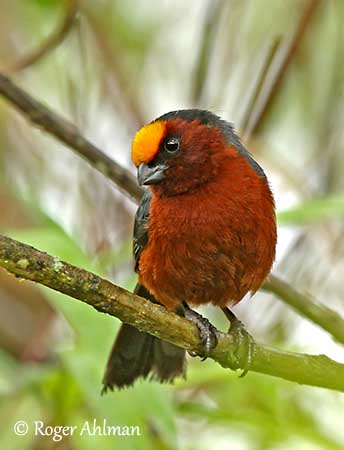
Fr: Tête-de-peluche couronné
Ang: Plushcap
All: Plüschkopftangare
Esp: Tangara Peluda
Ita: Fringuello dal diadema
Nd: Fluweelkaptangare
Sd: mestangara
Photographers:
Roger Ahlman
Pbase Galleries Peru and Ecuador
Ken Havard
My Bird Gallery & Flickr gallery 1 & Flickr gallery 2
Text by Nicole Bouglouan
Sources:
HANDBOOK OF THE BIRDS OF THE WORLD Vol 16 by Josep del Hoyo- Andrew Elliot-David Christie – Lynx Edicions – ISBN: 9788496553781
A GUIDE TO THE BIRDS OF COLOMBIA by Steven L. Hilty and William L. Brown - Princeton University Press – ISBN 069108372X
BIRDS OF SOUTH AMERICA – Passerines - by Robert S. Ridgely and Guy Tudor – HELM Field Guides – ISBN: 9781408113424
BirdLife International (BirdLife International)
Neotropical Birds – Cornell Lab of Ornithology
Wikipedia, the free encyclopaedia
The Guardian - Mystery bird: Plushcap, Catamblyrhynchus diadema
Plushcap
Catamblyrhynchus diadema
Passeriformes Order – Thraupidae Family
INTRODUCTION:
The Plushcap has still uncertain relationships. It has been placed in a separate monotypic family Caramblyrhynchidae within Emberizidae, but it is now included in the family Thraupidae, supported by molecular data. However, its evolutionary relationships remain mysterious.
The Plushcap has very distinctive appearance and behaviour, and it is currently placed in its own genus Catamblyrhyncus.
The bird’s name is derived from the stiff, plush-like, yellow forecrown feathers.

DESCRIPTION OF THE BIRD:
Biometrics:
Length: 14 cm
Weight: M: 15 g – F: 13,5 g
The adult male has entire upperparts bluish-grey, including scapulars and undertail-coverts. Primary coverts, flight-feathers and tail are dusky with brownish tinge and dull bluish-grey edges. The forked tail has pointed feathers with very narrow outer webs.
The underparts are rich chestnut from throat to undertail-coverts.
On the head, hindcrown and nape are blackish. Forehead and forecrown are golden yellow. These short feathers are dense and velvety, somewhat stiff and plush-like. Lores and eye area are dusky. Ear-coverts, cheeks, head sides, chin and throat are rich chestnut.
The black bill is stubby and heavy. The eyes are dark brown. Legs and feet are greyish tinged brown.
Male and female are similar, with male slightly larger than female.
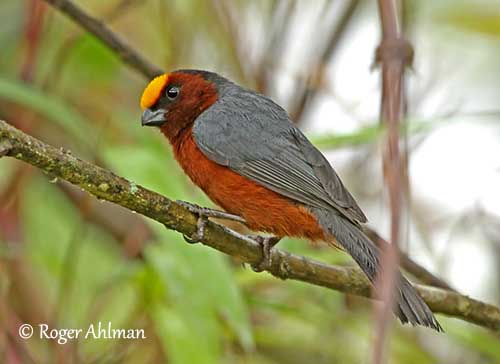
The juvenile is much duller than adults. It has dark grey forehead and forecrown. The upperparts are greyish-olive and the paler underparts are tinged rufous.
The immature shows some yellow on the forecrown at base of feathers. The overall plumage is brighter than in juvenile.
SUBSPECIES AND RANGE:
The Plushcap has three recognized subspecies.
C.d. diadema (described above) occurs in W Venezuela and Colombia, S to S Ecuador.
C.d. federalis is found in the coastal cordillera in N Venezuela. This race is slightly brighter overall than nominate, but it has paler chestnut undertail-coverts.
C.d. citrinifrons occurs in the Andes of Peru, S on west slope to Lambayeque and throughout east slope S to Bolivia and to NW Argentina. This race has yellow confined to forehead, bordered behind by narrow line of chestnut. The underparts are slightly paler than in nominate.
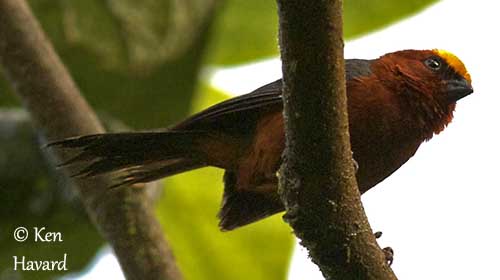
HABITAT:
The Plushcap frequents upper wet montane forest, woodlands and borders, and can be seen at or near the tree-line. It is almost invariably present in stands of Chusquea bamboo in all types of habitat.
This species occurs between 1800 and 3500 metres of elevation throughout its Andean range.
CALLS AND SONGS: SOUNDS BY XENO-CANTO
The Plushcap is usually quiet. While foraging, it gives high, soft “chip” notes. In Peru, the call is mostly a high “pseep” and “ti-ti-ti”.
An infrequent song can be heard in Peru, a monotonous series of unmusical “chip” or “tseep” notes and twitters which may last between 15 and 60 seconds “tseep-tseu-teep-ti-tsip-tseep…” This song resembles several Hemispingus tanager’s song.
BEHAVIOUR IN THE WILD:
The Plushcap feeds on insects and other arthropods, berries and small plant matter including bamboo stalks.
It is often inconspicuous in the dense growth. It forages actively, usually in pairs or alone, but sometimes in small family groups. However, it is regularly seen in mixed-species flocks, often small insect and fruit-eater species.
The Plushcap forages between one and six metres up in the understorey. Always very active, it rarely remains in view for long time and keeps on the move. It usually searches for food in Chusquea bamboo, hopping up the stems, twisting and peering to the side and examining carefully the vegetation. It often hangs upside-down while foraging.
It may forage in tall grass and shrubs too, but usually in the vicinity of bamboo.
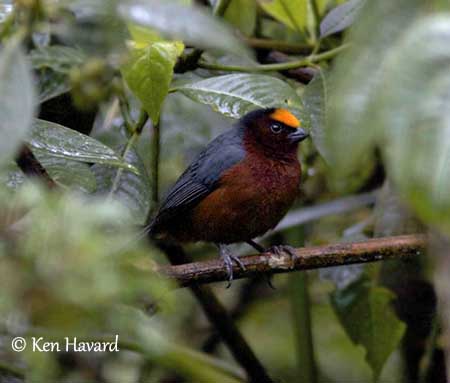
It looks for preys by probing and pushing the bill into stems and leaf nodes. It can be seen running its bill along the stems and “biting” or squeezing the stems of young bamboo as hopping up the canes.
It also hunts for insects by fluttering flight and gleans preys from the vegetation.
The breeding behaviour of this species is unknown. However, we can suggest that the conspicuous golden yellow feathers are enhanced during the displays.
The Plushcap is probably resident in its range.
Like most Thraupidae species, it is a good flier.
REPRODUCTION OF THIS SPECIES:
The breeding season occurs mainly during the wet season which provides abundant food resources, and especially insects.
The adults are seen in breeding conditions in June/July in N Colombia. Juveniles and immatures are reported between May and December from S Colombia to Bolivia.
In Venezuela, a juvenile was observed with adults in late December and immatures in early February.
In SE Ecuador, fledglings are reported in June, and in June/August in Peru.
No more information about breeding and nesting behaviour.
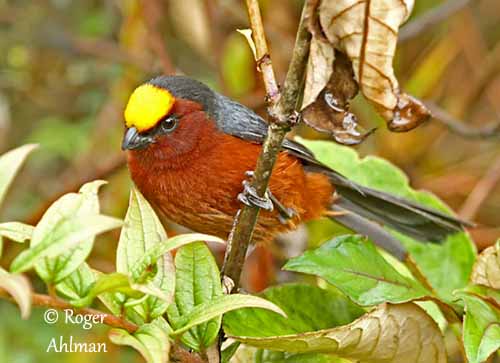
PROTECTION / THREATS / STATUS:
The Plushcap is threatened by habitat destruction through deforestation for agriculture and pasture expansion, logging and human settlements.
The race “federalis” is confined in a small area in Venezuela and is at risk with only a reduced suitable habitat with bamboo.
The Plushcap occurs in numerous protected areas and this species appears fairly common in suitable habitat.
However, in spite of the decreasing populations, the Plushcap is currently evaluated as Least Concern.
